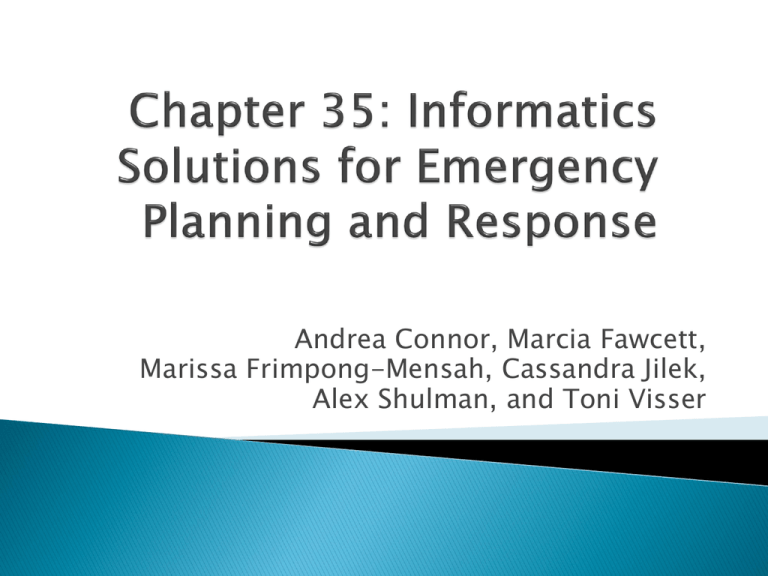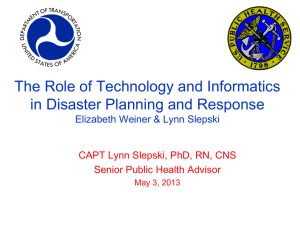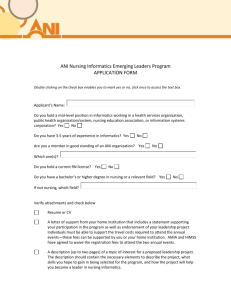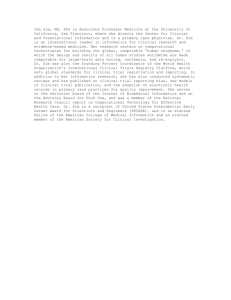Chapter 35 Informatics Solutions for Emergency Planningand
advertisement

Andrea Connor, Marcia Fawcett, Marissa Frimpong-Mensah, Cassandra Jilek, Alex Shulman, and Toni Visser There has been a rise in terrorism incidents, and natural disasters worldwide. Natural events range from earthquakes, tsunamis, floods, hurricanes, typhoons, to pandemic disease. Today, more than 40 countries with a combined population of more than 1.3 billion are faced with emergencies and humanitarian crises. Resulting in both planning and response efforts. Not immune from this increased emphasis on emergency preparedness. September 11, 2001, helped put the realization that the country was not adequately protected from terrorism. Anthrax outbreak stressed the public health infrastructure to the point that bioterrorism arose as an additional deadly threat. With these events, the States responded to better prepare and manage terrorist events. Earlier response by the informatics community focused on contributions toward: Surveillance of threat detection Biosurveillance and bioagent detection Increasing the efficiency in disaster response Providing a telepresence for remote medical care givers A challenge for emergency and disaster response continues to be communication and information management. Requires: a moment-to-moment “situational analysis” real-time information to assess needs and available resources that can change suddenly and unexpectedly These technologies are being used and evaluated to improve patient care and tracking, foster greater safety for patients and providers, enhance incident management at the scene, coordinate response efforts, and enhance informatics support at both the scene of the disaster and at the community resource levels. Technologies such as: Smart devices Wireless connectivity Positioning technologies In 2004, an earthquake and tsunami devastated Southeast Asia. The uncoordinated invasion of people and organizations resulted in duplication, competition, and failure to assist many victims in need. Initiated changes called the “humanitarian reform” ◦ Organized clusters whose principal mission was to assist the impacted government with coordination of all responses and with evaluation of the impact of intervention. Appointed as the lead agency for health. Includes coordination and production of health information. At global level, it aims at discouraging individual and organizational response efforts that were not part of this coordinated response. Government Operations Centre (GOC) Provides strategic-level coordination on behalf of the Government of Canada in response to an emerging or occurring event affecting the national interest lead the coordination, development and implementation of prevention, mitigation, preparedness, response and recovery strategies to maximize the safety and security of all Ontarians. http://www.emergencymanagementontario.c a/stellent/groups/public/@mcscs/@www/@e mo/documents/abstract/ec093297.pdf 2009 H1N1 influenza pandemic provides a recent illustration of how informatics can contribute to an emergency response. Believed to have major effects on global economy, especially travel, trade, tourism, food, consumption, and Eventually, investment and financial markets and could lead to widespread economic and social disruption. Results Many countries engaged in detailed pandemic planning and prepared to adopt draconianlike measures to delay but not stop the arrival of the virus, such as border closures and travel restrictions. Characterize the severity of a pandemic. Designed to predict the impact of a pandemic and provide local decision makers with standardized triggers that were matched to the severity of illness impacting a specific community. Based on a case-fatality ratio to measure the proportion of deaths among clinically ill persons. Monitors influenza activity and trends and virus characteristics through a nationwide surveillance system. Estimates the burden of flu illness using statistical modeling. Monitoring system tracked the real-time purchase of over-the-counter medication, such as fever reducers and influenza treatments, in over 29,000 retail pharmacies, groceries, and mass merchandise stores. Provides early detection of naturally occurring outbreaks as well as bioterrorism. Is a Department of Defense (USA) tool that fuses syndromic information from multiple data sources that differ in their medical specificity, spatial organization, scale, and time-series behaviours to provide early warning at the community level. Took chief complaint information from clinical encounters hospitals and classified it into one of seven syndrome categories using Bayesian classifiers. Data is stored in a relational database, used univariate and multivariate statistical detection Alerted users of when algorithms identify anomalous patterns in the syndrome count Now more than ever before consumers have the opportunity to contribute to surveillance activities. Some cases, the participation is a conscious decision, but in others consumers may be unknowingly contributing to this informatics process. Shorten the typical lag time to publication for CDC’s publicly reported data which can be from 10 to 14 days. Is being used to track influenza in specified geographic location with the added advantage that the data is real-time in nature. Assumption that there was a relationship between how many people search the internet for flu related topics and how many people have flu-like symptoms. Comparing to CDC published data, they found that the search-based flu estimates had a consistently strong correlation. Nurses must be appropriately and consistently educated to provide the right response. Provides an international infrastructure for nurses to learn about emergency preparedness and response. However, there are no accepted, standardized requirements for disaster nursing training or continuing education… yet! Identified: Nine objectively measurable skills for public health workers Seven competencies for leaders Three competencies for public health professionals, and Two competencies for public health technical and support staff Later renamed the Nursing Emergency Preparedness Coalition. Generated a list of 104 competency statements for all nurses responding to disasters using domains developed by the American Association of Colleges of Nursing. Requires: 1. Continuous monitoring of a variety of data 2. Standards for combining data from different sources and coordination of such efforts 3. Computer-based processing and analysis that help detect unusual and statistical significant patterns 4. Centralized diagnostic and therapeutic tools such as computer-based algorithms and protocols for treating conditions caused by infectious agents 5. Communication technology Incident management systems (IMS) was first used by firefighters to control disaster scenes in a multijurisdictional and interdepartmental manner. Calls for a hierarchical chain of command led by the incident manager or commander. Each job assignment is consistently followed by assigned personnel who refer to a specific job action sheet. Improves communication through a common language. Allows staff to move between management location. Facilitates all responders to understand the established chain of commands. Is a physical location where the Incident Management Team convenes to: ◦ Make decisions ◦ Communicate ◦ Coordinate the various activities in response to an incidents Accurate, real-time data acquisition regarding: ◦ Patient needs ◦ Rescue personnel ◦ Resources available Technology can be used to capture and represent data for purposes of increasing situational awareness in the Emergency Operations Center (EOC) for making the most informed and efficient decisions. (see Table 35.5, pp 520) Healthcare volunteers are a necessary components of mass casualty events but can also create challenges Questions to think about: ◦ How do you count volunteers so that they are only entered once? ◦ How do you educate them so that they can perform effectively when needed? ◦ How are liability issues dealt with? ◦ Are there certain tasks that lend themselves to volunteer efforts? Federal government system for organizing teams that are willing to travel to other regions if the country in the event of an emergency. When activated, members of the teams are federalized or made temporary workers of the federal government National network of community-based volunteer units that focus on improving the health, safety, and resiliency of their local communities. Include medical and public health professionals such as: ◦ ◦ ◦ ◦ ◦ ◦ Physicians Nurses Pharmacists Dentists Veterinarians Epidemiologist Require education prior to responding to an event. MRC unties have competency based education requirements. American Red Cross has a long history of volunteerism Regardless the group, nurses are urged to be a part of an organized group rather than just showing up to the disaster Health information technology investments are a necessary foundation in healthcare reform, linking potentially valuable information such as vaccination records and subsequent use of healthcare services to provide information about adverse events as well as vaccine effectiveness. Using “grids” to connect multiple computers across the country will allow data sources to share and view large amounts of health information. Grid participants will be able to analyze data in other jurisdiction with out moving the actual data Expanding the use of electronic health records should help both patients and their healthcare providers during times of emergencies and disasters. Improve clinical data and sharing of clinical information for displaced patients. 2009 H1N1outbreak reinforced the fact that estimating the number of actual flu cases is very challenging as current case counting relies on encounter information, which is prone to underreporting. Informatics has the potential to immediately support the early identification of a communicable disease, therefore reducing loss of life and the consumption of limited resources. Technology development will further enhance the ability to use informatics to detect first warning signs during an emergency. 1. What do you believe is the most important aspect of informatics solutions for emergency planning and response? 2. Do you think that nurses should be provided education based on emergency planning and response? Why? Saba, V. K., McCormick, A. (2011). Chapter 35 Informatics Solutions for Emergency Planning and Response. Essentials of nursing informatics (5th ed). McGraw-Hill. pp 513-523 http://www.emergencymanagementontario.ca/ english/home.html http://www.publicsafety.gc.ca/prg/em/indexeng.aspx





